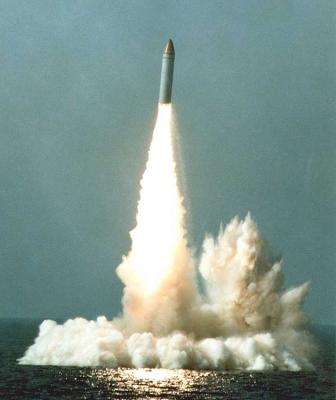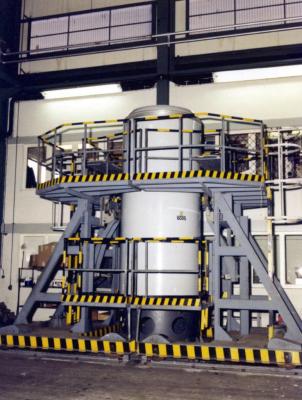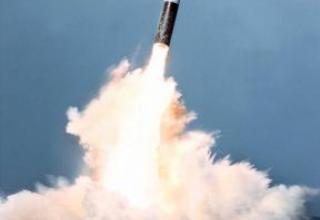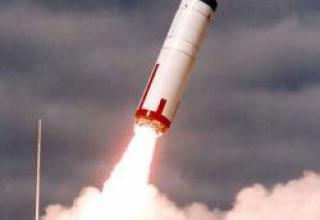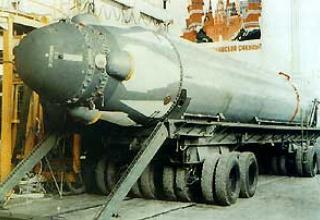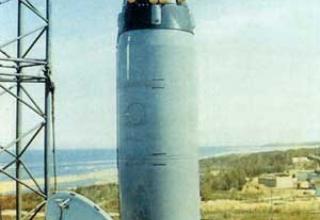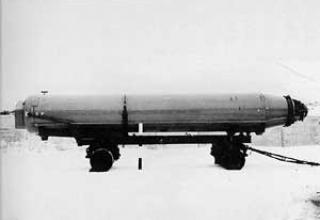The ballistic missile currently in service with the French naval strategic nuclear forces ("Force Oceanique Strategique"), the M45 SLBM, is the last of the M4 family, the first of which, the M4A missile, entered service with the French navy in 1985.
Development of the new SLBM, designed to dramatically improve the quality of combat equipment of the French nuclear submarine missile carriers, began in 1975. The missile, through the use of the latest advances in materials science, electronics, chemistry of solid fuels (all without exception French SLBMs had rocket engines running on solid fuel), as well as the use of thermonuclear charges of the new generation, was to meet the most serious requirements of the French military. The main innovation in the design of the new SLBM was to be a split head unit with thermonuclear warheads for individual targeting (it was planned to deploy up to 6 AB on each missile). Taking into account the prospects for the development of military equipment, it was decided to equip the new missiles and a new complex of means to overcome missile defense.
The creation of the new SLBM was started by almost the same group of contractors as the previous French missiles of this class. The scientific guidance was provided by the French National Ballistic and Aerodynamic Research Laboratory. Space and Strategic Systems Division" of "Aerospatiale" was appointed as the responsible contractor, the main components and units of the missile were manufactured at the company's plant in Le Mureau, a suburb of Paris. Solid fuel engines were developed and manufactured by SNPE in cooperation with SNECMA Moteurs. The control system was developed and produced by a consortium SAGEM/EMD. The "Direction des Affaires Militaires" division of the Commissariat a l'Energie Atomique was responsible for the production of the combat unit. Despite the decades that have elapsed since the work on the new compound began, many published data nevertheless remain rather contradictory. Some data have not yet been published.
Testing of prototypes of the new SLBM, designated M4, began in November 1980 at the French missile range "Biscarosse". The first rocket launches were carried out from the ground launch pad. In March 1982, the first launch of the M4 SLBM was carried out from aboard the experimental diesel-electric missile submarine "Le Gymnote". In October 1981, as part of the "military program 1984-1988" was finally approved the decision to increase the number of French SSBNs to 6, as well as the re-equipment of all previously built SSBNs of "Le Redoutable" class for new missiles. Test launches of the M4 missile were completed in February 1984, with 17 launches in total.
In the same year, mass production of these missiles began. The development of combat units for new missiles began in December 1972, the first test explosions as part of the development of new BC began in 1974 at the French training grounds in the Pacific Ocean. In 1978, the development of separate units of the new BCs, named TN-70, began, and the first combat units with TN-70, came to the French military in July 1983. In the same year the development of the improved TN-71 BCs began, which differed from its predecessor in the reduced inert mass with increased resistance to the damaging factors of a nuclear explosion. The production of the improved BC started in 1985.
The first submarine equipped with an M4 missile system - "L'Inflexible" - joined the French fleet in April 1985, thus becoming the sixth SSBN of the French Navy and the last class of "Le Redoutable". Already in May of the same year, the "L'Inflexible" entered the first combat patrol. The M4 complex significantly increased the capabilities of the French ISS: a sharp increase in range (1.5 times) and accuracy (CWO decreased by 2 times), coupled with the equipment of a new missile RGCH IN allowed in comparison with the M20 SLBM to expand the number and range of targets to hit the territory of the countries of the Warsaw Pact Organization (primarily, the USSR). Upgrading of the previously launched SSBNs to the "L'Inflexible" level immediately began - in 1987-1993, four modified Le Redoutable-class SSBNs became part of combat patrol ships again. It was decided not to upgrade the main submarine of this class, and in December 1991 it was withdrawn from the Constant Ready Force, and in 1992 it was decommissioned and then turned into a museum. All the upgraded submarines were armed with advanced M4 family rockets called M4B. M4B missiles with extended range received a BB with BC TN-71 and an improved SLC missile defense. To maintain the accuracy of firing, a set of works was carried out to improve a number of missile systems. Previously released missiles, the designers of which were equipped with BC TN-70, were named M4A. The first combat patrol with missiles M4V SSB "Le Tonnant" was released in December 1987.
Already at the beginning of the first half of the 1980s, the French military and political leadership began to analyze the prospects for the development of France's SSBNs, which led to the conclusion that it was necessary to develop and build a new class of SSBNs, which should replace the existing ones in the ratio of "one to one". The new submarine was to respond more fully to the threats and challenges that French analysts predicted for the last decade of the 20th and first decade of the 21st century. The new nuclear submarines were to be equipped with advanced SLBMs with extended range and more advanced UAVs as part of RSHI. However, the global political processes that were gaining momentum during the second half of the 1980s and ended with the dissolution of the IAB combined with the collapse of the USSR led to a significant reduction in funding for the French armed forces. The pace of construction of promising SSBNs at the DCN Cherbourg shipyard was drastically slowed down (the class headboat, named "Le Triomphant", was built in June 1989, the second one - only in December 1993). In addition, it was decided to limit the construction to only four submarines instead of the planned six. Given the reduced funding, given the significant technical difficulties, it was decided to equip the new SSBNs with improved M4 family SSBNs in the initial phase of their operation, the development of which began in the second half of the 1980s (according to some data, since 1986, the development of advanced BCs began in 1987). Due to various scientific and technical achievements, the new missile was to acquire significantly higher TTHs than the M4B SLBMs. Range of fire, accuracy of firing, area of deployment of combat equipment, resistance to fossil fuels should have been increased. It was planned to increase the probability that the missile would overcome the promising missile defense systems. The M45 missile was to fit into the new French strategic doctrine of "deterrence and deterrence", announced in 1994 - it was planned to provide high flexibility of the new SLBM application due to the expanded options of thermonuclear BC power and a large number of options of the ammunition explosion type. In addition, it was planned to be able to widely vary the number of ABs per missile from six to one. Plans were also considered to build a new generation of ground-based MRBMs based on the advanced M45 SLBM to replace the S-3 MRBMs that had been in service since 1980. The project to develop the new MRBM was closed in 1996, and within the next two years France finally got rid of this class of weapon.
The SSBN "Le Triomphant" was launched in March 1994, and three years later, in March 1997, was officially launched into the French Navy. The M45 SLBM test programme was completed in 1996. By that time, the last phase of testing of the new M45 SLBM, designated TN-75, had also been completed. This phase, which was conducted between October 1995 and January 1996 on the Fangataufa and Moruroa Pacific atolls, involved six submarine thermonuclear explosions and generated a strong international response, after which France acceded to the Treaty on the Cessation of Nuclear Tests. In 1995, the Centre d'Etudes de Valduc began mass production of a new BC, which lasted until 2003. Following the adoption of the new SSBNs, a decision was taken to withdraw obsolete submarines from the fleet. The first submarine, the "Le Terrible", was withdrawn from the Constant Ready Forces in July 1996, while the M4As and missiles were removed by the end of the same year. Le Foudroyant" SSBNs (April 1998) and "Le Tonnant" SSBNs (December 1999) were then withdrawn from the Constant Ready Forces. They were replaced by the latest SSBNs "Le Temeraire" (December 1999) and "Le Vigilant" (November 2004). By that time, in order to improve the combat capabilities of French ICSS and to make them more consistent with the new national strategic doctrine (since 2001) of "enhanced deterrence and flexible response", it was decided to modify the "L'Inflexible" SSBNs for M45 missiles. In order to reduce financial costs, it was decided to withdraw one submarine from the Constant Ready Forces (stabilizing the number of French SSBNs at 4) and to decommission M4B SLBMs. In 2004, after the completion of the testing program, the modified L'Inflexible returned to service. In April of the following 2005, the modernization of the French ISSJS was completed at this interim stage by the withdrawal of the L'Indomptable from the Constant Ready Forces and the decommissioning of the M4B SLBMs.
The French leadership sees further growth in the capabilities of its MCJSs as the adoption in 2010 of the M51 SLBM, which will be deployed on board the SSBN "Le Terrible" (the fourth and last Le Triomphant class). The new submarine was taken out of the factory shop in March 2008. The process of reducing the number of M45 carriers began in January 2008, when the obsolete L'Inflexible SSBN was removed from the Constant Ready Forces and sent for disarmament. According to plans, the previous three "Le Triomphant" class SSBNs will also be re-equipped with the new M51 SLBMs in 2011-2015, while M45 missiles will be decommissioned and the history of the French M4 family will be finally completed. However, in the initial phase (2010-2015) the deployment of M51 SLBMs will be equipped with combat units and M45 missile defense SLCMs.
All French SSBNs are traditionally based at the I'lle Longue base on the Atlantic coast of France, where a specialized basing point with all the necessary maintenance and operation facilities was created for them back in the late 60s - early 70s.
Evaluating the M4 family of missiles, it should be noted that the French have managed to create a new generation of SLBMs, which dramatically increased the potential of the French ISS. A programme to upgrade to M45 level has been implemented. However, despite all these achievements, the M4 family of missiles, even in its latest version of the M45, has not surpassed the Trident I C4 and R-39 SLBMs adopted in the late 1970s and early 1980s, respectively, not to mention the missiles of a later period such as R-29RM and Trident II D5.
Composition:
All M4 family SLBMs are three-stage, stage-by-stage missiles (see diagram). The M4B SLBM differs from the previous version of the M4A mainly in its combat equipment, being unified for the rest of the main elements. The M45 missile, while retaining the main design features of the previous missiles of the family, differs in the use of more advanced structural materials, solid propellants, electronics, etc. The M4B SLBM differs from the M4A in that it is unified with other main elements.
The first stage of all M4 family missiles is made of special high-strength heat-resistant steel. The designation of the first stage engine for M4A/M4B missiles is P401. The stage is equipped with a partially recessed controlled swivel nozzle in an articulated suspension, which allows for effective control of the missile in the active section of the trajectory through the channels of pitch and yaw. The main structural material of the nozzle is a special grade titanium alloy with ablation coating. Fuel of the first stage is a solid blend, bonded to the motor body. The main structural solutions for the first stage, used on the M4A/M4B SLBM, have been preserved on the M45 SLBM as well. Such continuity allowed to test and establish production of the improved SLBM in a relatively short period of time under difficult conditions of financial difficulties and limited production capabilities. The traction of the M45 first stage engine at sea level is 70 tons, operating time is 65 seconds and solid propellant mass is 17 tons.
The second marching stage of all M4 family rockets is made of fiberglass by winding method with impregnation with special epoxy resins. The designation of the second stage engine for M4A/M4B - P402 missiles. The stage is equipped with a partially recessed controlled swivel nozzle in an articulated suspension, which allows for effective control of the missile in the active section of the trajectory through the channels of pitch and yaw. The main structural material of the nozzle is a special grade titanium alloy with ablation coating. The fuel of the second stage is a solid blend, bonded to the motor body. The main design solutions for the second stage, used on early M4 family SLBMs, were preserved on M45. The second stage engine draught of the M45 is 45 tons in vacuum, operating time - 75 seconds, solid propellant mass - 7 tons.
The third stage of all M4 family missiles is made of organic aramid fiber (Kevlar-49 type for M4A/M4B) by winding method with impregnation with special binder resins. The designation of the third stage motor for M4A/M4B missiles is P403. The stage is equipped with a partially recessed controlled swivel nozzle in an articulated suspension, which allows effective control of the missile in the active section of the trajectory through the channels of pitch and yaw. The main structural material of the nozzle is a special grade titanium alloy with ablation coating. The fuel of the third stage is a solid blend, bonded to the motor body. The stage is equipped with special holes that are opened when separation of the breeding stage with the HF, which allows you to shut down the third stage engine and take it to the side to prevent collision. The basic third stage design has been applied without major alterations to all SLBMs in the family. The draught of the third stage engine of M45 rocket in vacuum is 30 tons, operating time - 45 seconds, mass of solid fuel - 1 ton.
All marching stages of the SLBM family are of the same diameter as each other. The heel control at the marching stage operation area is performed with the help of low-power gas generators. Separation of steps is made by a standard method by explosion of a detonating cord in a place of connection of steps with preliminary supercharging of interstage space by means of gas generators. The cable routes are led to the outer surface of the missile and covered with a fairing.
M4 family rockets are the first French rockets on which a separable head unit is installed, providing individual guidance of combat units. For the M4A/M4B missiles, the area of deployment of combat equipment is more than 50,000 km2, and for the M45 missile, more than 60,000 km2. All the missiles carry up to 6 BB with a thermonuclear warhead: M4A - BB with TN-70 BC with a power of 150 kt; M4B - BB with TN-71 BC with a power of 150 kt, the improved BC has increased resistance to fossil fuels and a smaller mass, M4B missiles according to some data are also lightened with increased resistance to fossil fuels and reduced radar visibility. The greatest improvements were made to the RF of M45 missiles - the missile received new lightweight high-speed low-profile ballistic missiles with increased resistance to foammable substances, and the new TN-75 BC with a maximum power of 150 kt has not only increased resistance to foammable substances, but also the ability to choose the blast power. The new BC/TB assembly is also characterized by greater flexibility in the choice of options for detonation, and the M45 missile has an opportunity to significantly vary the number of BCs in the RSH (reducing the number of BCs to one in the so-called "additional-strategic" application option increases the range of M45 up to 7500 km).
The breeding stage on all SLBMs of M4 family is solid-fuel, contains a compartment, where the inertial control system of the rocket with gyrostabilized platform and accelerometers, as well as BCVM is placed. Containers with an anti-missile defense system are also located there. The combat units are covered by a head fairing, which is discharged in the active flight area and led away by low-power solid propellant engines. On the M45 missile, the control system is supplemented with a computerized payload distribution control unit, which improves the efficiency of the dilution stage power plant.
All M4 family SLBMs are designed to be launched from a submarine at depths up to 30-50 m, depending on the SSBN class. The first missile could be prepared for launch for a time period of 30 to 10 minutes, depending on the submarine class and electronics level (which was upgraded to reduce the prelaunch preparation time), and the next within 20-15 seconds. The rockets from the launchers are fired by steam-gas. The walls of the launch glass have several rows of obturation rings, and from above it is closed by a dome membrane made of phenolic resin reinforced with asbestos. The vapour mixture required to eject the missile from the mine is produced by the PADs. The gases they generate first pass through a water tank (cooling chamber), mix with it in certain proportions and form low-temperature steam. This steam enters the chamber formed by the skimmer of the rocket and the bottom of the mine.
On the Le Redoutable-class SSBNs, all 16 SLBMs are placed in two rows of launchers in the same compartment. On Le Triomphant class SSBNs, the missiles are mounted in two compartments in two rows (8 SLBMs in each compartment). According to some data, French SSBNs also have the capability to launch their missiles from an above-water position, including a basing point. The automated combat control system installed on the SSBNs provides automatic monitoring of the state of the missiles in the ABI, preparing them for launch, redirecting them if necessary, and launching them. In particular, the SAT ASU used on Le Redoutable class SSBNs used 4 digital computers combined through a common bus in two pairs to control, control, divert and launch the SLBMs. Another computer could be used as "hot standby" if needed.
Characteristics:
| М4В (М4А) | М45 | |
| Length, m | 11,07 | 11,05 |
| Diameter, m | 1,92 | 1,93 |
| Start weight, t | 35 | 36 |
| Range of fire, km | 5000 (4500) | 6000 |
| KVO, m | 500 | 350 |
| Number of combat units, pcs. | 6 | 6 |
| Battle unit power, kt | 150 | 150 |
Testing:
Terms of development of the M-1 complex were ahead of the terms of delivery of the head ship at Prospect 61 of Plant № 1701 (SKR-25 from 9.10.62 "Komsomolets of Ukraine") - so the Order of the USSR CM № 2110 of 30.07.1959. joint tests of M-1 were transferred to the rocket ship "Bravy" pr.56K. Tests on "Bravo" were held in two stages - from 5.01.62 to 12.03.62 and from 12.03.62 to 30.04.62. During the tests it was noted that the time of "Yatagan" exit from the cold position was 5 minutes, the range of "Yatagan" escorting the target was 42 km with a 50% probability of capture and 36 km with a probability of 80%. The missile's range was 15 km, and the self-destruct time was 26 seconds.
During the tests of the complex was shot down six target aircraft MiG-15M, flying at an altitude of 0.6 to 10 km, with missiles missed from 9 to 48 meters. According to the commission, the probability of hitting the aircraft at a miss of 20 meters is 0.9, while at a miss of 40 meters - 0.4-0.6. The M-1 complex could hit targets flying at a speed of up to 600 meters per second. The target can maneuver at altitudes up to 4 km with an overload of 3 - 4 g, and at high altitudes - up to 2 - 3 g. The speed of the ship during launches can be up to 36 knots. There was no firing from Bravoi on surface targets.
According to the results of tests on "Bravoi" the M-1 SAM system was recommended for adoption for service.
Sources:
- www.defense.gouv.fr/marine
- www.netmarine.net
- www.aviationweek.com
- www.defence-aerospace.com
- www.nuclearweaponarchive.org
- www.globalsecurity.org
- www.space.eads.net
- www.naval-technology.com
- www.dcnsgroup.com
- www.cdi.org
- www.arms.ru
- www.ship.bsu.by
- www.warships.ru
- Национальная оборона, 2006, №4.
- Ю.В.Апальков, Д.И.Мант, С.Д.Мант "Отечественные баллистические ракеты морского базирования и их носители", 2006 г.
